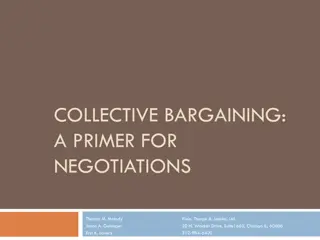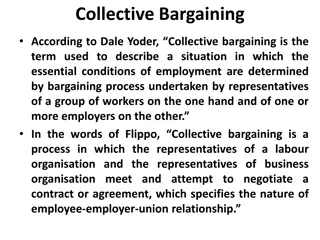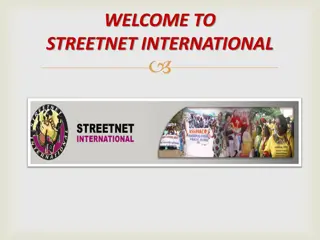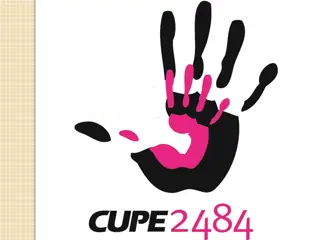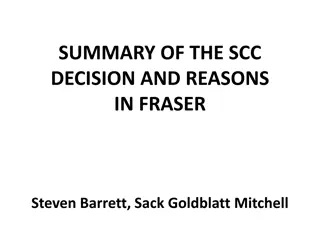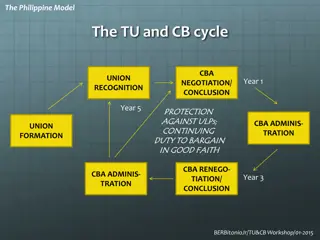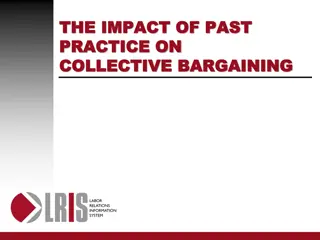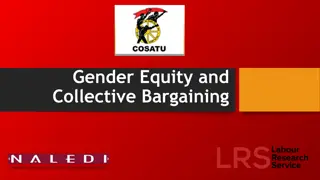Collective Bargaining in the Workplace
Collective bargaining involves negotiations between employers and workers to establish employment terms and conditions. This fundamental right helps reduce inequalities and provide labor protection. The process includes discussing changes in employment conditions, working hours, wages, benefits, and more. Discover the steps involved and the different issues addressed in collective bargaining.
Download Presentation

Please find below an Image/Link to download the presentation.
The content on the website is provided AS IS for your information and personal use only. It may not be sold, licensed, or shared on other websites without obtaining consent from the author.If you encounter any issues during the download, it is possible that the publisher has removed the file from their server.
You are allowed to download the files provided on this website for personal or commercial use, subject to the condition that they are used lawfully. All files are the property of their respective owners.
The content on the website is provided AS IS for your information and personal use only. It may not be sold, licensed, or shared on other websites without obtaining consent from the author.
E N D
Presentation Transcript
Dr Digvijay Sharma School of Health Sciences
Collective Bargaining The term collective bargaining refers to the negotiation of employment terms between an employer and a group of workers. Employees are normally represented by a labor union during collective bargaining. The terms negotiated during collective bargaining can include working conditions, salaries and compensation, working hours, and benefits. The goal is to come up with a collective bargaining agreement through a written contract. According to the International Labour Organization, collective bargaining is a fundamental right for all employees.3
How Collective Bargaining Works As noted above, the International Labour Organization (ILO) states that collective bargaining is a fundamental right available to all workers. This means that all employees are entitled to present their grievances to their employers and to be able to negotiate them. According to the ILO, collective bargaining helps reduce inequalities in the workplace while providing workers with labor protection. Collective bargaining normally takes place between members of corporate management and labor union leaders, who are elected by workers to represent them and their interests. Collective bargaining is initiated when employee contracts are up for renewal or when employers make changes to the workplace or contracts.
Changes of Collective Bargaining These changes include, but aren't limited to: Employment conditions Working conditions and other workplace rules Base pay, wages, and overtime pay Work hours and shift length Holidays, sick leave, and vacation time Benefits related to issues such as retirementand healthcare12
Issues of collective Bargaining These issues fall into three different categories, which are referred to as mandatory subjects, voluntary subjects, and illegal subjects. Mandatory subjects include anything that the law requires of the employer, such as salary, overtime, and workplace safety. Voluntary subjects include negotiable things the law doesn't require like union issues and decisions about employer board members. Illegal subjects involve anything that violates laws, such as workplace discrimination.2 The goal of collective bargaining is called a collective bargaining agreement. This agreement is meant to establish rules of employment for a set number of years. Union members pay for the cost of this representation in the form of union dues. The collective bargaining process may involve antagonistic labor strikes or employee lockouts if the two sides have trouble reaching an agreement.
Steps Collective bargaining can be an intense process that can be stressful and difficult for all parties involved. It often involves a lot of back-and-forths, with offers and counteroffers. But the end goal is to reach an agreement. The process goes through a number of stages. These steps can be summed up as follows: Identifying the issues and preparing the demands Negotiating Coming to a tentative agreement Accepting and ratifying the agreement Administering the agreement5,6
There are instances, though, where the parties involved can't come to an agreement. If the negotiation period expires without a collective bargaining agreement in place, union representatives may suggest that workers go on strike until their demands are met. Employers, on the other hand, may decide to lock out their employees until a suitable agreement is reached. If they are locked out, employees have the right to picket. In most cases, neither party wants to reach these points, which are considered drastic measures that are used as a last resort.7
Types Not all types of collective bargaining are the same. In fact, collective bargaining can be divided into several categories. We've noted some of the most common types below.5
Composite Bargaining Composite bargaining has nothing to do with compensation. Instead, it focuses on other issues, such as working conditions, job security, and other corporate policies, These may include hiring and firing practices as well as workplace discipline. The goal of composite bargaining is to come up with a suitable agreement leading to a lasting and harmonious relationship between employers and their employees.
Concessionary Bargaining As its name implies, concessionary bargaining focuses on union leaders making concessions in exchange for job security. This is common during an economic downturn orrecession. Union leaders may agree to give up certain benefits in order to guarantee the survival of the employee pool and, ultimately, of the business.
Distributive Bargaining This process is characterized as benefitting one party financially at the expense of the other. This can come through increased bonuses, salaries, or any other financial benefits. Distributive bargaining normally favors workers over employers. Unions must have a higher degree of power in order for distributive bargaining to work. Higher membership means more power. If an employer refuses to accept a union's demands, it can call a strike.
Integrative Bargaining Each party tries to benefit through integrative bargaining, which is why it's often referred to as a form of win-win bargaining. Each side tries to consider the other's position and bring issues to the table that aim to benefit both parties. As such, employees and employers both stand to lose and gain with integrative bargaining.
Productivity Bargaining This type of bargaining revolves around compensation and the productivity of employees. Labor union leaders often use higher salaries and compensation as a way to boost employee productivity, which leads to higher profits and value for the employer. In order for this kind of bargaining to work, both parties need to agree to financial terms in order to increase productivity.
Advantages As the name implies, workers have a larger voice through collective bargaining. Being in a group with the same goal(s) gives employees more power to negotiate demands with their employers. Companies may be able to shut out the voices of one or two employees but can't necessarily do the same with a larger group of unified individuals. Workplace conditions can see significant improvements and guarantee all workers with the same protections under collective bargaining. This includes the implementation of health and safety checks as well as suitable salaries, overtime pay, and vacation time. Employers and employees are fully aware of their rights and responsibilities under a collective bargaining agreement. Once employment terms are negotiated, a contract is drawn up. Both parties agree to the terms, which are clearly defined.
Disadvantages As mentioned above, collective bargaining is often a long, drawn-out process that can take weeks or even months. Employers and labor union leaders may have to go back and forth with employment terms. Union leaders are required to update employees and must put the terms to a vote. If employees vote to reject a contract, the negotiating process begins again. Collective bargaining often comes at a high cost. Employees and employers may have to take time off from work in order to negotiate. This means less time on the job and, therefore, a drop in productivity. Lengthy negotiations can affect a company's bottom line. The process is often considered biased. Because employees are able to band together under a single union, employers may be forced to negotiate and accept unfavorable terms in order to keep their businesses running without much disruption.
Refrences 1.AFL-CIO. "Collective Bargaining." Accessed Oct. 6, 2021. 2.SHRM. "What is a collective bargaining agreement?" Accessed Oct. 6, 2021. 3.International Labour Organization. "Collective bargaining and labour relations." Accessed Oct. 6, 2021. 5. BoyceWire. "Collective Bargaining Definition." Accessed Oct. 6, 2021 6. MVOrganizing.org. "What are the 5 core steps of collective bargaining?" Accessed Oct. 6, 2021. 7.go2HR. "STRIKES, LOCKOUTS, PICKETING AND REPLACEMENT WORKERS." Accessed Oct. 6, 2021.





